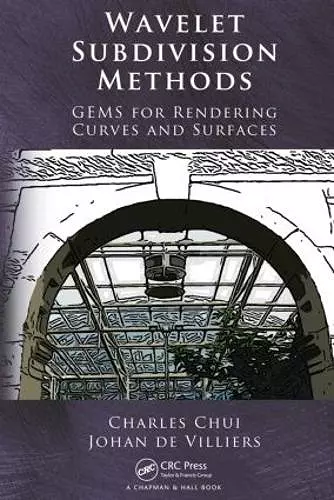Wavelet Subdivision Methods
GEMS for Rendering Curves and Surfaces
Charles Chui author Johan de Villiers author
Format:Hardback
Publisher:Taylor & Francis Inc
Published:23rd Aug '10
Currently unavailable, our supplier has not provided us a restock date
This hardback is available in another edition too:
- Paperback£63.99(9780367452315)

Prevalent in animation movies and interactive games, subdivision methods allow users to design and implement simple but efficient schemes for rendering curves and surfaces. Adding to the current subdivision toolbox, Wavelet Subdivision Methods: GEMS for Rendering Curves and Surfaces introduces geometry editing and manipulation schemes (GEMS) and covers both subdivision and wavelet analysis for generating and editing parametric curves and surfaces of desirable geometric shapes. The authors develop a complete constructive theory and effective algorithms to derive synthesis wavelets with minimum support and any desirable order of vanishing moments, along with decomposition filters.
Through numerous examples, the book shows how to represent curves and construct convergent subdivision schemes. It comprehensively details subdivision schemes for parametric curve rendering, offering complete algorithms for implementation and theoretical development as well as detailed examples of the most commonly used schemes for rendering both open and closed curves. It also develops an existence and regularity theory for the interpolatory scaling function and extends cardinal B-splines to box splines for surface subdivision.
Keeping mathematical derivations at an elementary level without sacrificing mathematical rigor, this book shows how to apply bottom-up wavelet algorithms to curve and surface editing. It offers an accessible approach to subdivision methods that integrates the techniques and algorithms of bottom-up wavelets.
The monograph contains many examples, figures, and more than 300 exercises. It is friendly written for a broad readership and very convenient for students and researchers in applied mathematics and computer science. Doubtless, this nice book will stimulate further research in modeling of curves and surfaces with wavelet subdivision methods. -Manfred Tasche, Zentralblatt MATH 1202 All topics are treated with great care, and a lot of effort is put into stating results and proofs with a very high precision and accuracy. This makes the book so self-contained that its list of references consists of only 24 items. This is exceptional for a monograph of 450 pages and quite clearly shows the intention of the authors and the approach they have taken for their book. ... the book provides everything that is useful, for example, for classroom use: examples, exercises (even with marked difficulty levels), a carefully compiled index and even a very impressive reading guide. ... Its extraordinary attention to detail makes it useful to undergraduate students or researchers who want to get familiar with the fundamental techniques of stationary subdivision, who want to see "how the machine works inside". -Tomas Sauer, Mathematical Reviews, Issue 2011k This book is the first writing that introduces and incorporates the wavelet component of the bottom-up subdivision scheme. A complete constructive theory, together with effective algorithms, is developed to derive such synthesis wavelets and analysis wavelet filters. The book contains a large collection of carefully prepared exercises and can be used both for classroom teaching and for self study. The authors have been in the forefront for advances in wavelets and wavelet subdivision methods and I congratulate them for writing such a comprehensive text. -From the Foreword by Tom Lyche, University of Oslo, Norway
ISBN: 9781439812150
Dimensions: unknown
Weight: 816g
480 pages